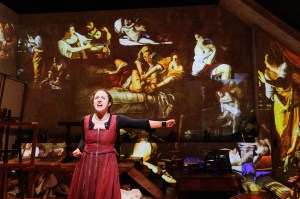Gary: A Sequel to Titus Andronicus and the Clowns Who Mop Up the Bodies
Nathan Lane, Kristine Nielsen, and Julie White star in Taylor Mac’s macabre new comedy.
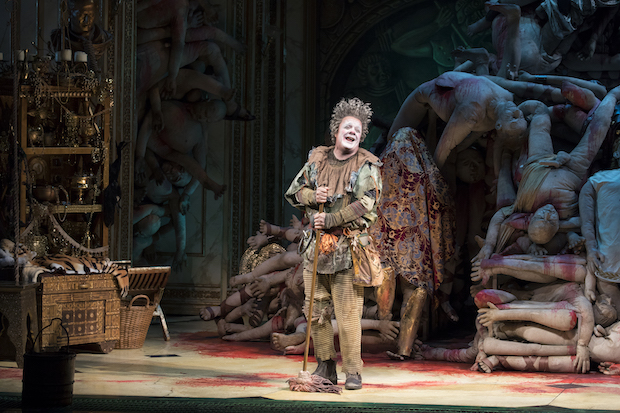
(© Julieta Cervantes)
Taylor Mac's Gary: A Sequel to Titus Andronicus is hands down the strangest new show on Broadway. I say that with admiration, because it is truly awesome that Scott Rudin and a team of producers are mounting a commercial run of a play that even Broadway's not-for-profits would have the good sense to steer clear of — not because it is bad, but because it is just so very weird. With so many significant revivals of Tennessee Williams and Edward Albee to choose from, I love that this brand-new, blood-soaked bastard child of Samuel Beckett and the Bard is what is playing right now in the Booth Theatre, the epicenter of Broadway.
The title is an accurate description of what this play is about. It takes place just after the final scene of Shakespeare's earliest, bloodiest, campiest tragedy. Gary (Nathan Lane), a clown recently promoted to maid, has been hired to assist in the cleanup. Veteran domestic Janice (Kristine Nielsen) trains him on how to evacuate gas and fluids from the corpses and stack them neatly along the walls, but Gary soon becomes distracted. Like a recently hired MBA, he already has an eye on the next job: He wants to become a fool, which he defines as "a clown with ambition." He plots how to use his new station to impress the surviving court with his fooling. Janice is dismissive at first, but even she cannot help but indulge in his fantasy of social mobility.
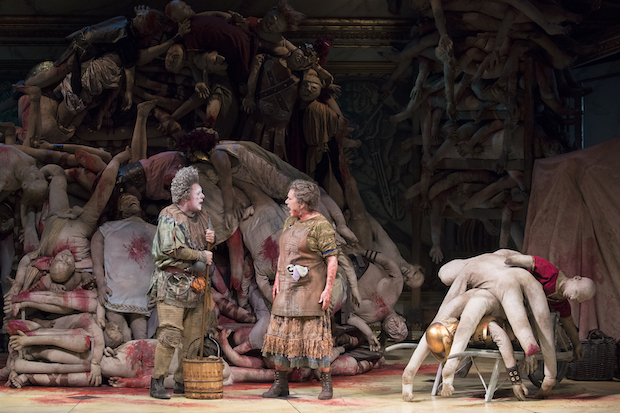
(© Julieta Cervantes)
Lane and Nielsen are two of our greatest stage comedians, and their back-and-forth is one of the delights of Gary (as are the moments of physical comedy, brilliantly choreographed by clown extraordinaire Bill Irwin). Lane's Gary is a dim-witted slacker, while Nielsen's Janice is an embittered female administrator of the status quo. As he jokes around, she seethes, fantasizing about the demolition of the male power structure. They are a comedy duo to rival Laurel and Hardy, Nichols and May, and even Vladimir and Estragon. That's because Lane and Nielsen understand that a thin line separates comedy and tragedy, and they both ride that razor's edge for 85 hilarious and disturbing minutes.
Julie White regularly upstages them both as Carol, the midwife who delivered the illegitimate child of Tamora and Aaron — and who was knifed by the latter for her efforts. Neither rich nor poor, Carol is thoroughly in the middle, and haunted by her complicity in the crimes of her employers. White embodies her with a quirky angst that is outsized and, at the same time, utterly relatable. It may not come as a surprise that between these three larger-than-life performers, a fair amount of scenery is devoured — but of the trio, White seems to be enjoying the meal most.
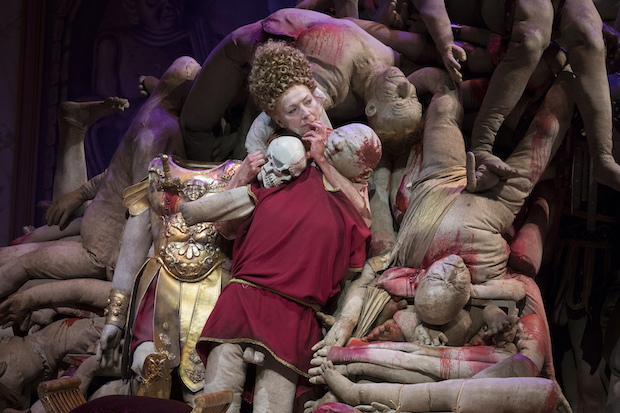
(© Julieta Cervantes)
Mac's gleeful riff on three fringe characters in Titus owes a debt to Tom Stoppard's Rosencrantz and Guildenstern Are Dead, which told the story of Hamlet from the perspective of the Prince of Denmark's two college buddies. But Mac's frequent use of rhyming couplets (and the ostentatious wig design of Campbell Young Associates) recalls the comedies of Molière. Gary and Janice remind us of the gravediggers in Hamlet and the old couple from Happy Days, waist-deep in a pile of human refuse. As they crawled over that mountain of cadavers looking for props for Gary's court spectacle, I wondered if I wasn't looking at a visual metaphor for the theater. In Gary, Mac presents a gruesome yet somehow reassuring vision of culture born out of morbid appropriation. It's a message that comes through at the Booth, though not as forcefully as it could.
While director George C. Wolfe has staged a first-class production, it still has an air of timidity that seems to be hindering the play from reaching its full potential. Scenic designer Santo Loquasto has filled a room with bodies and booty, the blood and treasure of a senseless conflict between rapacious elites. But those cartoonish dummies and their ridiculous phalli are comfortingly fake. A more realistic design might have helped to sustain the tension between genuine horror and comedy, without which the play occasionally sags.
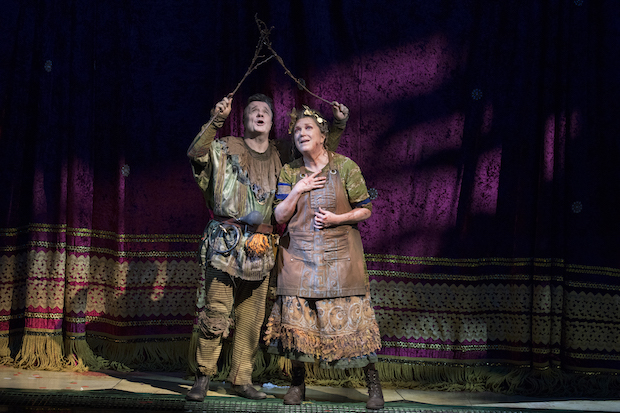
(© Julieta Cervantes)
Ann Roth has designed colorful and detailed costumes that still (just barely) read as rags. Jules Fisher and Peggy Eisenhauer's elegant lighting trickles in from the heavens, illuminating the ghastly scene. With his sound design, Dan Moses Schreier hints at the violent world beyond this chamber, and composer Danny Elfman (yes, that one), underscores Nielsen's late soliloquy in particularly gorgeous fashion, making it all the more touching. It's all very beautiful — perhaps too beautiful for a play about the end of the world.
For indeed, that is what these late Romans think they are living through (end-times panic is a perennial fad). In Gary, Mac offers funhouse mirror reflections of contemporary America in the optimistic-verging-on-delusional Gary; the vengefully woke Janice; and Carol, whose guilt has led to a kind of paralysis. Provided you can keep an open mind and a fortified stomach, Gary will leave you with a lot to digest as you leave the theater. Its presence in this season thrillingly asserts that Broadway can still be a home for challenging new American plays.








